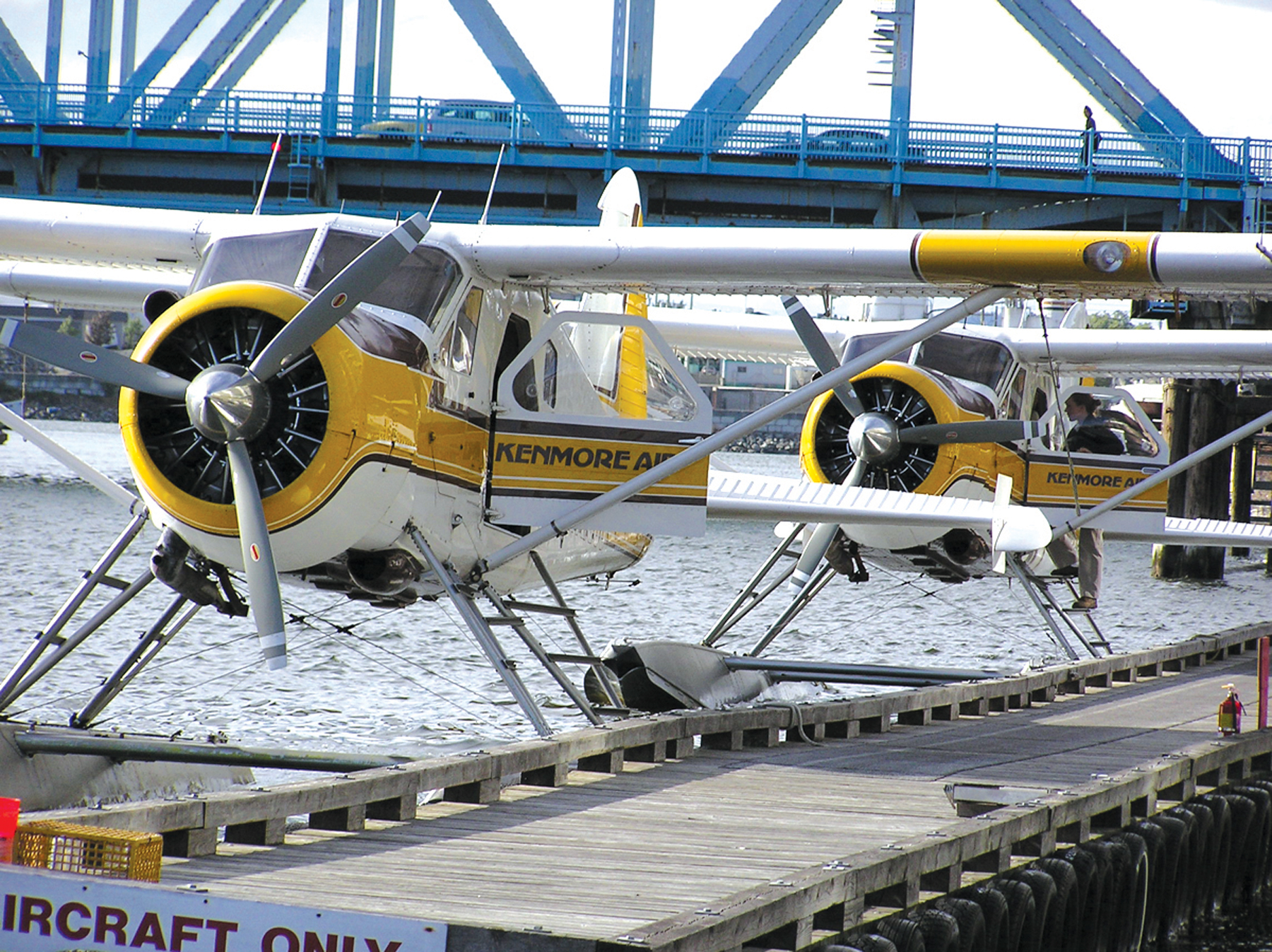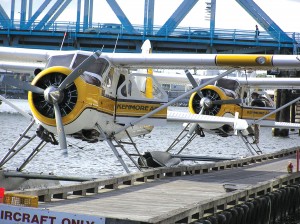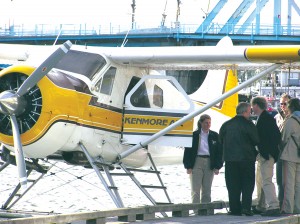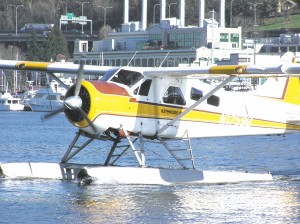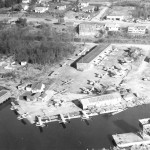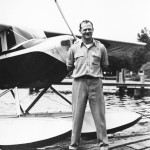By Terry Stephens,
Harrison Ford, Bill Gates, Katherine Hepburn, Neil Armstrong and Jimmy Buffett all have one thing in common. They’ve all flown with Seattle-based Kenmore Air, the nation’s largest floatplane airline.
Beginning 60 years ago with a single Aeronca Model K on floats, Kenmore Air now offers chartered and scheduled flights in the Pacific Northwest and Canada with a fleet of 25 aircraft, primarily de Havilland Beavers and Otters. Among the celebrities who have flown out of Kenmore Air’s home port on Lake Washington, Ford has probably spent the most time there. The long-time actor and aviator was so fascinated with the Beaver Kenmore Air provided for one of his movies that he asked the airline to find one for him, and later began taking flying lessons at Lake Washington.
“The first time I’d ever flown a Beaver was when I played a freight pilot in ‘Six Days and Seven Nights.’ I did most of the flying during the filming, and I fell in love with the plane,” he wrote in the introduction to “Success on the Step,” C. Marin Faure’s history of Kenmore Air. “They stopped making Beavers in 1967, so I knew the only way I’d ever get one was to find one to rebuild. When I started asking who did the best job of restoring old Beavers, I kept getting the same answer: Kenmore Air.”
What the airline found for Ford was an abandoned Beaver carcass destined for the salvage heap, until Kenmore Air rescued it. The plane was built in 1955, and a veteran of tough times in the Vietnam War. The remains were almost unrecognizable, until brought to life by the company’s restoration experts, who have restored 135 Beavers for the Kenmore Air fleet and customers around the world.
But Kenmore Air’s global reputation for restoring old Beavers is only a footnote to what it’s primarily known for in Pacific Northwest aviation history: being a family-owned business that has become the nation’s largest floatplane airline. More than 1.25 million passengers have flown with the airline since it began in 1946. Today, Kenmore Air makes scheduled and chartered flights to more than 75 Northwest destinations, including the San Juan Islands and Victoria, B.C. More than two million miles are logged annually, carrying more than 75,000 people for business, recreation and commuting trips.
The airline has three flight centers in the Seattle area. Kenmore Air Harbor, in the city of Kenmore, at the north end of Lake Washington, is where the airline was started. Another center is on Lake Union, in downtown Seattle; that site was gained when Kenmore Air bought its primary competitor, Lake Union Air, some years ago. The last site is at Boeing Field, where wheeled planes like its Cessna Caravan fly scheduled routes to the San Juan Islands, Port Angeles on the Olympic Peninsula, and into British Columbia.
Tourists fly to Victoria for a day trip or overnight stay, or to relax at bed-and-breakfasts in the island resorts, and many residents and boaters in the islands want to occasionally make quick trips to Seattle. Also, because of the Internet and today’s global telecommunication networks, many people have fulltime businesses in the San Juans, but fly regularly to Seattle or other destinations for meetings. Using the Northwest’s abundance of thousands of miles of water for landing sites, Kenmore Air has made floatplanes a popular alternative for everything from sightseeing and vacation island-hopping to business trips and fishing in remote mountain lakes.
Legendary pioneer aviator Bob Munro founded the airline in 1946. He died in 2000, but six decades after it was founded, Kenmore Air remains a flourishing family business. Munro’s son, Gregg, flies the left seat as president of the 250-employee enterprise. Leslie Banks, Munro’s daughter, continues as office manager, and her son, Todd, is the airline’s general manager.
Today, Kenmore Air’s planes seem to be everywhere in the Northwest. That’s a tremendous accomplishment for the tiny business that began when Bob Munro and two high school friends, Jack Mines and Reg Collins, were reunited after World War II and decided to venture into an aviation business. Munro and Collins were mechanics, and Mines was a pilot. They thought that was all the experience they needed.
“We didn’t have much of a plan, other than Reg and I would fix planes and Jack would give flying lessons,” Munro said at the time. “We just assumed it was going to work.”
They started the company with no business plan, no growth plan, no marketing plan and a single airplane, an Aeronca Model K on EDO aluminum floats. When Mines was killed in a crash in the Cascade Mountains, and Collins decided to pursue other ventures in California, Munro, who had learned to fly from Mines, took over the business. He began expanding the airline’s services.
Instead of having a dry-land base with thousands of feet of runway, Munro had thousands and thousands of feet of runway on the surface of Lake Washington, on the east side of Seattle. But the heart of his flying operation was a single hangar on a damp swamp bog holding a few small buildings. Those structures at the north end of the lake once housed a shingle mill.
In the late 1940s, Kenmore Air became a Seabee dealer for the Northwest. That helped make Republic’s seaplane a popular aircraft in an area with a wealth of water landing strips, from Puget Sound to mountain lakes. At their peak of popularity, almost 40 Seabees were based at Kenmore Air Harbor, although the company owned only one of its own. The company also became expert at repairing and maintaining the Seabees, a business pattern that continued with all the aircraft Kenmore added to its fleet.
In the 1950s, Kenmore signed up as an aircraft and parts dealer for Cessna and began its charter business. The company also leased a plane to the U.S. Government for a mapping survey in Alaska. Later, contracts with the U.S. Navy established more flying business for Kenmore. Those contracts continue today.
By the early 1960s, the airline had added a new hangar and office building to its Kenmore seaplane base. The company also acquired its first de Havilland Beaver, which led to decades of rebuilding and modifying this popular Alaskan floatplane.
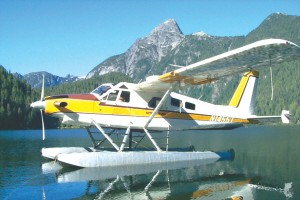
Fishing trips to mountain lakes and sightseeing tours of the Northwest’s mountain scenery are popular flight choices for Kenmore Air passengers.
In the 1970s, Bob Munro even began flying University of Washington scientists and their supplies to a glacier at the 6,500-foot level of Mount Olympus, on the Olympic Peninsula west of Seattle. Visits to the mountain ice sheet provided numerous harrowing flights for the scientists, but Munro loved the challenge. He could land his Beaver on a flat area at the top of the glacier, but there was no place large enough for taking off—except down the surface of the glacier itself.
A superb pilot, Munro still recognized the dangers in that plan and flew those mountain missions himself, refusing to risk Kenmore’s other pilots in the venture. His plan was simple. He fired up the engine, edged the plane to where the ledge dropped off toward the valley floor, and then tipped over the edge and slid down the 4,000-foot-long glacier, until he gained enough speed to lift off from the ice and snow. He said the only real risk was miscalculating whether he had enough “runway” to take off, before hitting deep crevasses near the bottom of the glacier.
But most of the airline’s flying was much less exciting, carrying passengers to a growing variety of Northwest destinations at sea level. In the 1980s, continuing to grow, Kenmore Air acquired a smaller floatplane airline in Seattle to broaden its operations. Otter Air, flying de Havilland Otter floatplanes, was providing scheduled service between Seattle and Victoria, B.C. In the late 1990s, Kenmore acquired its primary competitor, Lake Union Air, headquartered in the shadow of Seattle’s downtown high-rises. Later, more Turbo Otters were added to the fleet to meet increased passenger demand, creating the largest Otter-equipped airline in the world.
With more than 50 pilots on staff, the airline now operates a fleet of Beavers, including turbine-powered models, as well as turbine-equipped Otters and new Cessna Caravans. The fastest planes in the lineup, the wheeled Caravans, carry up to nine passengers between land bases in the Northwest. Two Cessna 180s and two Super Cubs are used for flight training, a growing segment of Kenmore Air’s business.
A year ago, Kenmore Air Express launched five flights a day, seven days a week, between Boeing Field and William R. Fairchild International Airport in Port Angeles, on the Olympic Peninsula. To make the flights even more attractive, compared to long drives from Port Angeles to Seattle-Tacoma International Airport, Kenmore Air provides flights of less than an hour, as well as free shuttle transportation between Boeing Field and Sea-Tac.
“When Horizon Airlines, with bigger planes, pulled out of Port Angeles two years ago, we thought we might be able to fill that gap with our smaller planes, for more economy,” General Manager Todd Banks said. “Now, we’re filling planes everyday and offering more trips than Horizon used to provide.”
The airline’s land planes provide four daily flights to the San Juan Islands, a vacation and resort area. Flights are increased to five daily flights during the summer. The routes and destinations are the same ones Kenmore Air has been flying with floatplanes for many years, but the wheeled planes have opened up new markets.
“Wheel planes give us access to different areas than our floatplane network and help us increase winter flights and revenues when weather is often too bad for floatplane flights,” he said. “We’re looking at adding Canada’s Campbell River, a major fishing and resort area, to our land-plane routes in June.”
Kenmore Air also provides sightseeing flights over Seattle and Puget Sound, including flying into the Cascade Mountains and the Ross Lake National Recreation Area. There are also flights to Poets Cove Resort and Spa in Canada’s Gulf Islands and to the San Juan Islands for whale-watching boat trips, in search of Orcas that live in the area.
Flights into the harbor at Victoria provide opportunities to stay at the historic Fairmont Empress Hotel, the Hotel Grand Pacific (adjacent to the Parliament building) or the Laurel Point Inn on the harbor, among many others. The Butchart Gardens and the world famous Royal B.C. Museum are at the top of visitors’ sightseeing lists there.
Promoting its flights online, Kenmore Air also features nearly 50 Internet specials for those who make reservations on its website (www.kenmoreair.com). Information on the site includes photos, maps and details of all of Kenmore Air’s scheduled and chartered flights, services and aircraft.
For pilots who want to earn a single-engine sea rating, Kenmore offers a course that includes floatplane flying from step-taxiing to rough water takeoffs and glassy water landings. Kenmore Air’s seasoned water pilots teach the fine points of reading water currents and how to handle takeoffs and landings with a variety of winds, water depths and surfaces.
The company’s success has been based on much more than great planes and great flying, however. It was Bob Munro’s attitude about running his business, his goals and his standards for success that really made the difference. Even when Kenmore Air was only a fledgling enterprise, Munro focused on his personal business philosophy: Do the right thing. He applied that thought equally to Kenmore Air’s customers, employees and suppliers.

Kenmore Air’s crews check out one of the airline’s floatplanes in preparation for the day’s flights.
For his own guidance, he once wrote out the personal goals he lived by all of his life: “Dedicate yourself to achieve success in whatever you do. Have your priorities in order. Be willing to take risks and be confident in your ideas. And don’t work necessarily for money but for accomplishment.”
Banks said those same business and personal goals are still the focus for those who operate Kenmore Air.
“Things just keep going here, because of a lot of dedicated people, a lot of support from the aviation community, and because we continue to always try to treat people right,” said Banks.
For more information about Kenmore Air, visit [http://www.kenmoreair.com] or call 800-543-9595.
- In the 1950s, Kenmore Air was a dealership for Republic Seabees, one of the Northwest’s most popular seaplanes for many years.
- Kenmore Air founder Bob Munro was the Northwest authority on floatplanes for more than half a century. He pioneered floatplane flights with the Aeronca Model K, Seabees and de Havilland Beavers and Otters.











